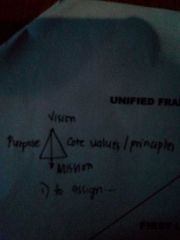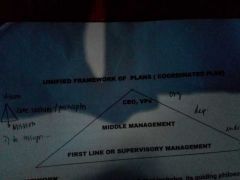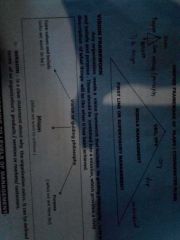![]()
![]()
![]()
Use LEFT and RIGHT arrow keys to navigate between flashcards;
Use UP and DOWN arrow keys to flip the card;
H to show hint;
A reads text to speech;
48 Cards in this Set
- Front
- Back
|
It is a logical and systematic approach of formulating objectives, programs, policies, procedures, budgets, rules and regulations, and other type of plans. |
Planning |
|
|
Four Major factors that summarize the essential nature of planning |
1. Contribution to purpose and objectives 2. Planning as the first basic function 3. Planning as a function of all managers 4. Planning for efficient organization |
|
|
To facilitate accomplishment of business purposes and objectives |
Contribution to purpose and objectives |
|
|
Planning is logically performed before the execution of all other managerial function |
Planning as the first basic function |
|
|
... though the character and scope of planning will differ from one authority to another |
Planning as a function of all managers |
|
|
The efficiency of a plan is evaluated by the amount it contributes to purpose and objectives as offset by the expenses and other things required to formulate and implement it |
Planning for efficient organization |
|
|
Importance of Planning |
1. To offset uncertainty and change 2. To focus attention to planned targets 3. To gain economical and efficient operation 4. To facilitate control |
|
|
Planning allows the organization to determine the constraints, specify the planned target, select the number of options, monitor and control the implementation so as to allow replanning if necessary. - back up or second plan |
To offset uncertainty and change |
|
|
It unifies the work activities of the different personnel of the organization to act as one party. |
To focus attention to planned targets |
|
|
It minimizes cost. It's emphasis is on efficient and effective operations and consistency of procedures and methods. |
To gain econimical and efficient operation |
|
|
Managers cannot always check on the accomplishments or failures of their subordinate |
To facilitate control |
|
|
Guidelines for good planning |
1. A plan should have specific planned targets 2. A good plan should facilitate action 3. If many people are involved in planning, coordination and communication are very important to arrive at realistic result 4. Good plans can be constantly, improved, redrafted, and replanned. What may change are strategies and programs of achieving the planned targets. 5. Planning may be delegated to a formal training staff or group within the company. 6. All plans are tentative and interim. They never fault. They should be flexible not rigid |
|
|
Plans should be SMART |
Simple Measurable Attainable Realistic Time bounded |
|
|
Objectives defined |
- are clear cut and carefully considered statements designed to give an organization and it's members direction and purpose - it is synonymous to aim, purpose, goal, and mission - objectives are established at organizatonal, departmental, or individual level. |
|
|
Kinds of Objectives |
1. Organizational Objectives 2. Managerial/Departmental Objectives 3. Individual Objectives |
|
|
Deal with the general direction and purposes of an organization |
Organizational Objectives |
|
|
Identify the goals of particular department, or organization segement. |
Managerial/Departmental Objectives |
|
|
Are personalized objectives which outline what individuals in the group are trying to accomplish |
Individual Objectives |
|
|
Characteristics of Objectives |
1. Must be specific, clear and concise 2. Must be practical 3. Must be quantifiable or measurable |
|
|
Must give precise meaning to the manager |
Must be specific/clear/concise |
|
|
Must be within the capacity of the individual or group to achieve |
Must be Practical |
|
|
Ex. To increase the production of Coca-Cola's 8 ounce soft drink by 12% by August 11 |
Must be quantifiable or measurable |
|
|
Types of setting objectives |
Profitability Customer service Employee-management needs and well-being |
|
|
This can be measured in terms of profits, Return on Investment and Earnings Per Share |
Profitability |
|
|
Can be expressed in a very explicit terms Ex. To reduce the number of complaints by... |
Customer service |
|
|
This may be quantitatively expressed in terms of number of grievances, training, etc. |
Employee-Management needs and well being |
|
|
It is the continuing commitment by business to behave ethically and contribute economic development while improving the quality of life of the workforce as well as the local community and society at large. |
Corporate Social Responsibilty |
|
|
Flow |

|
|
|
Unified framework of plans (coordinated plans) |

|
|
|
Vision Framework |

|
|
|
Clear statement about why the organization exists. It can be defined in terms of an organization's products/services or markets/customers |
Mission |
|
|
Types of Planning according to level of managemet |
1. Strategic Planning. (Top Level Management) 2. Tactical Management (Middle Level Management) 3. Primary Operational Planning (First Level Management) |
|
|
Concerned with the entire operation. It reflects the broad overall concepts of an Enterprise operation. It begins with org's mission |
Strategic Planning |
|
|
Method of shaping a company's future and involves determining the long-run direction of the organization. It outlines the basic steps and Management intends to do to achieve it's objectives. |
Strategy |
|
|
Some activities in strategic planning |
1. Choosing company planned targets 2. Planning the organization 3. Setting personnel policies 4. Setting financial policies 5. Setting marketing policies |
|
|
Are the means to achieve a strategy, to activate it and make it works |
Tactical Plans |
|
|
Some activities in tactical planning |
1. Formulating budgets 3. Formulating personnel practices 2. Planning the staff line3. Formulating personnel practices4. Working capital expenditures line3. Formulating personnel practices4. Working capital expenditures 4. Working capital expenditures |
|
|
Is one that a manager uses to accomplish his job responsibilities. It can be a single use plan or an ongoing plan |
Operating Plan |
|
|
Types of operating plans |
1. Single use plans (program, budget) 2. Ongoing Plans (Policy, procedures, Rules) |
|
|
Actual course of action designed to carry out the established objectives Can be easily and systematically shown using a project schedule and drawn using a Gantt chart (Marketing and Personnel Program) |
Program |
|
|
Plan stated in financial terms. Also called a "numberized program" |
Budget |
|
|
The basic guidelines for action. These are broad, general guides for action which constraint or direct objective attainment (personnel policy |
Policy |
|
|
Set of step-by-step directions in which activities are to be carried out and expressed in chronological order for a specific purpose. |
Procedures |
|
|
Specific plans for controlling human behavior and conduct at work. Do's and don'ts statements |
Rules |
|
|
Types of planning according to range of plans |
Short-range plans Long range plans |
|
|
Plans for a short period of time (6mons-1yr) |
Short range plans |
|
|
Plans for a long period of time (5-20yrs) |
Long range plans |
|
|
How Management Gets Results |
1. Management by Objectives (MBO) 2. Management by Exceptions (MBE) 3. Management by Committees (MBC) 4. Total Quality Management (TQM) |

